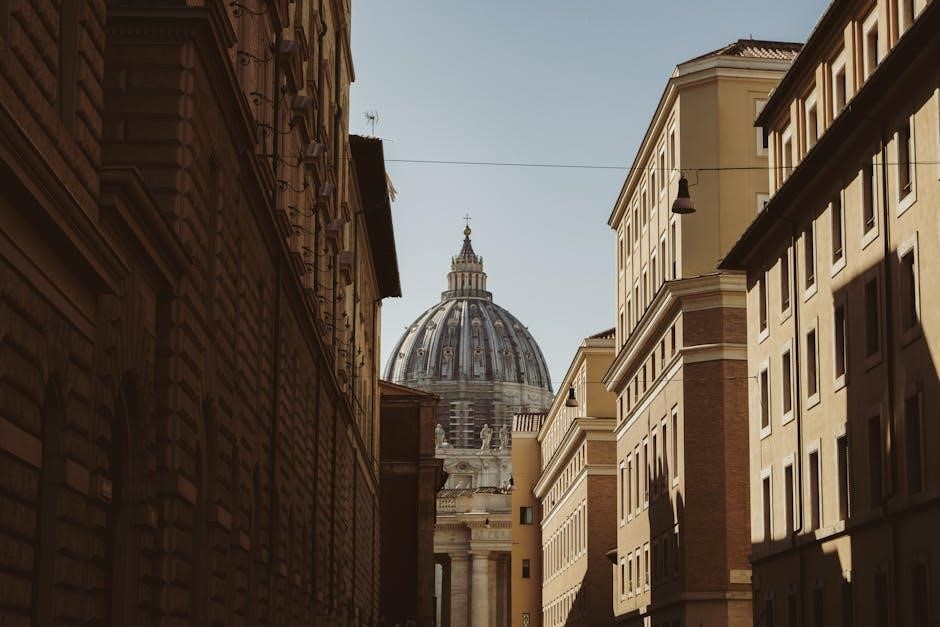The Vatican‚ a city-state steeped in history and spirituality‚ holds secrets tied to its archives‚ mysterious artifacts‚ and controversial events‚ fueling endless intrigue and debate.
Overview of Vatican City and Its Historical Significance
Vatican City‚ the world’s smallest independent nation‚ is nestled within Rome‚ Italy‚ and serves as the spiritual and administrative heart of the Roman Catholic Church. Established in 1929‚ it traces its historical significance to the 4th century‚ when Christianity’s roots began to flourish. The city is renowned for iconic landmarks like St. Peter’s Basilica‚ the Sistine Chapel‚ and the Vatican Museums‚ which house masterpieces by Michelangelo and Raphael. As the seat of the Pope‚ Vatican City embodies a unique blend of religious‚ cultural‚ and political influence. Its history is intertwined with pivotal moments in Christianity‚ from the Renaissance to modern times‚ making it a focal point of global fascination and pilgrimage. The Vatican’s enduring legacy lies in its preservation of faith‚ art‚ and history‚ captivating millions worldwide.
The Concept of “Secrets” and Their Cultural Impact
The Vatican’s secrets have long captivated global imagination‚ fueling conspiracy theories and cultural fascination. These mysteries range from hidden archives and ancient texts to unexplained artifacts and controversial historical events. The idea of concealed knowledge within the Vatican’s walls has inspired countless books‚ films‚ and debates‚ shaping popular culture. Works like “The Da Vinci Code” and “The Secrets of the Vatican” by Douglas Sladen have amplified this intrigue‚ blending fact with fiction. The perception of secrecy surrounding the Vatican has not only influenced literature and media but also sparked philosophical discussions about faith‚ power‚ and transparency. This enigmatic reputation continues to draw scholars‚ tourists‚ and theorists‚ cementing the Vatican’s place in the collective consciousness as a symbol of mystery and hidden truths.
Historical Secrets of the Vatican
The Vatican’s historical secrets encompass ancient archives‚ mysterious documents‚ and unseen artifacts‚ preserving centuries of papal history and fueling endless speculation and cultural intrigue.
The Founding of Vatican City and Its Evolution
Vatican City‚ established in 1929 through the Lateran Treaty‚ traces its roots to the early Christian era. Its evolution began with the construction of St. Peter’s Basilica in the 4th century‚ marking the burial site of Saint Peter. Over centuries‚ the Vatican grew into a spiritual and administrative center‚ housing iconic landmarks like the Sistine Chapel and the Vatican Museums. The city-state’s sovereignty was formally recognized in modern times‚ solidifying its role as the heart of the Catholic Church. This tiny nation‚ rich in history and art‚ continues to captivate the world with its unique blend of spirituality‚ culture‚ and intrigue.
The Vatican Secret Archives: History and Purpose
Founded in 1612 by Pope Paul V‚ the Vatican Secret Archives house centuries of historical documents tied to the Catholic Church. Originally established to preserve records of the Holy See‚ the archives include sensitive materials like the trial of Galileo and documents from World War II. Accessible only to authorized scholars since 1881‚ the archives aim to protect and study Church history rather than conceal secrets. Recent efforts have opened certain sections‚ such as Pope Pius XII’s records‚ to address historical controversies and promote transparency‚ revealing the archives’ role as a repository of knowledge rather than a vault of hidden truths.
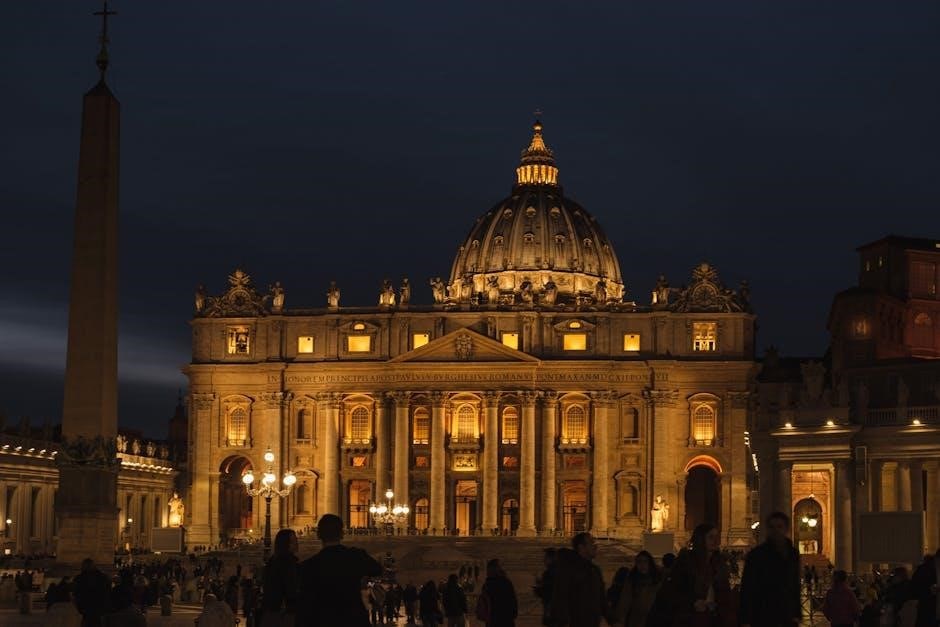
Mysteries and Legends Surrounding the Vatican
The Vatican is shrouded in theories about extraterrestrial life‚ hidden relics‚ and cryptic symbols‚ fueling speculation and intrigue among conspiracy theorists and historians alike.
Conspiracy Theories: Aliens and Hidden Artifacts
Conspiracy theories surrounding the Vatican often involve claims of alien life and hidden artifacts. Some speculate that the Vatican has discovered evidence of extraterrestrial beings‚ such as elongated skulls found beneath the city in 1998‚ resembling those depicted in science fiction. These theories suggest the Vatican conceals such findings to avoid undermining religious beliefs. Additionally‚ rumors persist about hidden artifacts‚ possibly linked to ancient civilizations or mysterious technologies‚ stored within the Vatican’s secret archives. These claims‚ though unverified‚ have been popularized in books and media‚ fueling public intrigue. While the Vatican denies these allegations‚ the enigmatic nature of its archives continues to spark speculation‚ blending fiction and history in a captivating narrative.
Legends of Hidden Texts and Forbidden Knowledge
Legends surrounding the Vatican often highlight hidden texts and forbidden knowledge‚ sparking curiosity and intrigue. The Vatican Library is rumored to house ancient manuscripts and rare books‚ some believed to contain suppressed knowledge or alternative histories. Conspiracy theorists suggest these texts could challenge established religious doctrines or reveal secrets about humanity’s past. While the Vatican denies such claims‚ the restricted access to its archives fuels speculation. Some legends point to forgotten scrolls or encrypted documents hidden within the library’s vast collections‚ hinting at mysteries waiting to be uncovered. These rumors‚ though unverified‚ contribute to the Vatican’s enigmatic reputation as a guardian of hidden truths‚ blending historical fact with captivating lore.
The Vatican’s Role in World War II
The Vatican’s controversial ties to Hitler’s regime and its role in financial scandals during World War II raise significant ethical questions about its neutrality and actions.
Pope Pius XII and His Controversial Actions
Pope Pius XII’s role during World War II remains a subject of intense debate. Critics accuse him of failing to publicly condemn Nazi atrocities‚ while supporters argue he worked secretly to protect Jews. The Vatican Bank’s financial dealings with Hitler’s regime further fuel controversy. Recent archival openings provide insight into his actions‚ yet his legacy remains divisive‚ with some viewing him as a silent bystander to genocide‚ others as a cautious leader navigating a perilous geopolitical landscape. His decisions continue to spark heated discussions about moral responsibility and diplomacy during one of history’s darkest periods.
The Vatican Bank and Financial Scandals
The Vatican Bank‚ officially known as the Institute for the Works of Religion (IOR)‚ has been embroiled in numerous financial scandals. Historically‚ it faced allegations of laundering money for organized crime groups and its ties to the regime of Nazi Germany under Hitler. Gerald Posner‚ a historian‚ highlighted that the Vatican reportedly received Church Tax from Hitler annually‚ raising ethical concerns. These financial dealings have cast a shadow over the Vatican’s moral authority. Efforts to modernize and increase transparency have been made‚ yet the bank’s historical involvement in questionable transactions continues to be a source of public skepticism and scrutiny‚ reflecting broader issues of accountability within the Vatican’s financial structures.
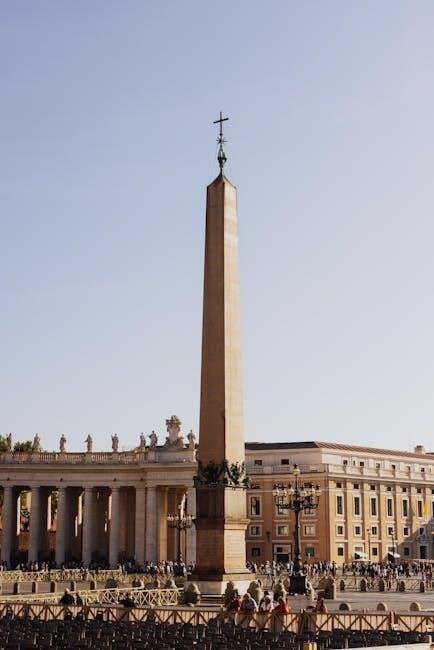
The Vatican Library and Its Secrets
The Vatican Library holds ancient manuscripts and forbidden knowledge‚ preserving centuries of history. Its secrets include rare texts and mysterious documents‚ some still inaccessible to the public.
The Vatican Apostolic Library: A Treasure Trove of Knowledge
The Vatican Apostolic Library is a repository of ancient manuscripts‚ rare texts‚ and historical documents‚ preserving centuries of knowledge. Established in 1475‚ it houses over 1.6 million printed books and countless manuscripts‚ including works on theology‚ philosophy‚ and science; The library is renowned for its collection of illuminated manuscripts and forbidden texts‚ some of which remain inaccessible to the public due to their sensitive nature. Scholars view it as a treasure trove for understanding the Church’s history and intellectual contributions. Despite its restricted access‚ the library continues to inspire curiosity and fascination‚ with rumors of hidden knowledge and secrets within its walls fueling endless speculation.
Forbidden Books and Ancient Manuscripts
The Vatican Apostolic Library harbors a collection of forbidden books and ancient manuscripts‚ many of which remain inaccessible to the public. These texts‚ often deemed controversial or heretical‚ include works on alchemy‚ mysticism‚ and alternative religious doctrines. Among the most notable is the Malleus Maleficarum‚ a 15th-century treatise on witchcraft; The library also preserves ancient manuscripts‚ such as the Codex Vaticanus‚ a biblical manuscript from the 4th century. These texts are not only historically significant but also shrouded in mystery‚ fueling speculation about their contents and the reasons for their restricted access. The Vatican’s careful guardianship of these works underscores the delicate balance between preserving knowledge and maintaining doctrinal integrity.
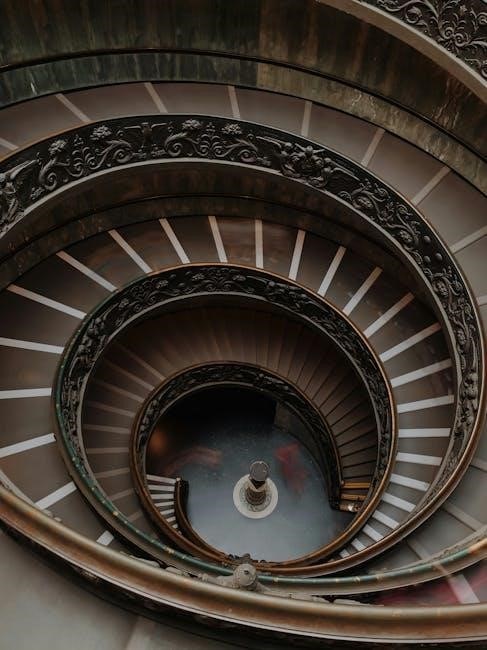
Art and Architecture in the Vatican
The Vatican is renowned for its breathtaking art and architecture‚ including St. Peter’s Basilica‚ the Sistine Chapel‚ and the Vatican Museums‚ showcasing masterpieces by Michelangelo and others.
St. Peter’s Basilica: History and Hidden Symbols
St. Peter’s Basilica‚ one of the Vatican’s most iconic landmarks‚ was built over the tomb of Saint Peter‚ a key figure in Christianity. Designed by Donato Bramante‚ Michelangelo‚ and Gian Lorenzo Bernini‚ the basilica is a masterpiece of Renaissance architecture. Its towering dome‚ designed by Michelangelo‚ dominates the skyline of Vatican City. The basilica is adorned with intricate mosaics‚ sculptures‚ and symbolic art‚ including the Baldacchino‚ a monumental bronze canopy over Peter’s tomb. Hidden symbols and religious motifs are embedded in its design‚ reflecting centuries of spiritual and artistic tradition. Pilgrims and visitors alike are drawn to its grandeur and historical significance‚ making it a central piece of the Vatican’s cultural and religious identity.
The Sistine Chapel: Michelangelo’s Masterpiece
The Sistine Chapel is renowned for Michelangelo’s breathtaking ceiling‚ painted between 1508 and 1512. This iconic work depicts scenes from the Book of Genesis‚ including the famous “Creation of Adam.” The chapel‚ part of the Vatican Museums‚ attracts millions annually. Its walls feature intricate frescoes by artists like Botticelli and Perugino‚ while Michelangelo’s “The Last Judgment” adorns the altar wall. The Sistine Chapel is not only a religious space but also a testament to Renaissance artistry. Its intricate details and vibrant colors continue to inspire awe‚ blending spiritual themes with artistic genius. This masterpiece remains central to the Vatican’s cultural legacy‚ embodying the intersection of faith and art.

Scandals and Controversies
The Vatican has faced numerous scandals‚ including the Vatican Bank’s alleged ties to Nazi Germany and financial misconduct‚ sparking widespread criticism and calls for transparency.
The Vatican Bank Scandals and Money Laundering
The Vatican Bank‚ officially known as the Institute for the Works of Religion (IOR)‚ has been embroiled in multiple scandals‚ including allegations of money laundering and ties to organized crime. These issues gained prominence in the 20th century‚ with historians like Gerald Posner highlighting the bank’s alleged dealings with Nazi Germany. The Vatican reportedly received Church Tax from Hitler annually‚ raising ethical questions. In recent years‚ the bank has faced legal scrutiny‚ with funds seized and investigations launched into suspicious transactions. These controversies have led to calls for greater transparency and reform within the Vatican’s financial institutions‚ overshadowing its mission to support religious works. The scandals have significantly tarnished the Vatican’s reputation‚ prompting internal and external demands for accountability.
Sexual Abuse Scandals and Cover-Ups
The Vatican has faced severe criticism for its handling of sexual abuse cases within the Catholic Church‚ with allegations of widespread cover-ups and systemic failures. Revelations of priests abusing minors have shocked the global community‚ with the Church accused of prioritizing institutional reputation over justice for victims. The scandal gained prominence in 2002 when the Boston Globe exposed decades of abuse and cover-ups‚ leading to a global outcry. Critics argue that the Vatican’s hierarchical structure and emphasis on confidentiality enabled perpetrators to evade accountability. Victims have reported emotional and psychological trauma‚ compounded by the Church’s slow response. Pope Francis has acknowledged the crisis‚ implementing reforms‚ but many argue more decisive action is needed to address the deep-rooted issues and restore trust in the institution.
Spiritual and Religious Secrets
The Vatican guards secretive spiritual practices‚ including exorcisms and indulgences‚ sparking debate on their role in modern faith. These traditions remain shrouded in mystery and controversy.
The Vatican’s Stance on Exorcisms and Demons
The Vatican officially recognizes demonic possession and has trained priests to perform exorcisms. Despite modern skepticism‚ the Church maintains rituals to address spiritual battles‚ viewing exorcisms as a rare but legitimate practice. The process involves prayer‚ blessings‚ and sacred symbols‚ aiming to free individuals from perceived evil influences. While the Vatican emphasizes that exorcisms are only conducted after medical and psychological evaluations rule out other causes‚ the secretive nature of these rituals fuels public intrigue and speculation. This practice reflects the Church’s enduring belief in the supernatural and its role in combating perceived darkness‚ bridging ancient traditions with contemporary spiritual challenges.
Indulgences and the Commercialization of Faith
The Vatican has long been criticized for the practice of indulgences‚ which some view as the commercialization of faith. Indulgences‚ historically‚ were granted to reduce punishment for sins‚ often in exchange for prayers‚ donations‚ or pilgrimages. This practice led to widespread abuse‚ notably during the Protestant Reformation‚ when indulgences were openly sold‚ sparking outrage and calls for reform. While the Vatican has officially condemned the sale of indulgences‚ critics argue that the concept itself blurs the line between spirituality and material gain. Modern interpretations emphasize charitable acts and devotion‚ yet the legacy of indulgences remains a contentious topic‚ symbolizing the Church’s complex relationship with wealth and power.
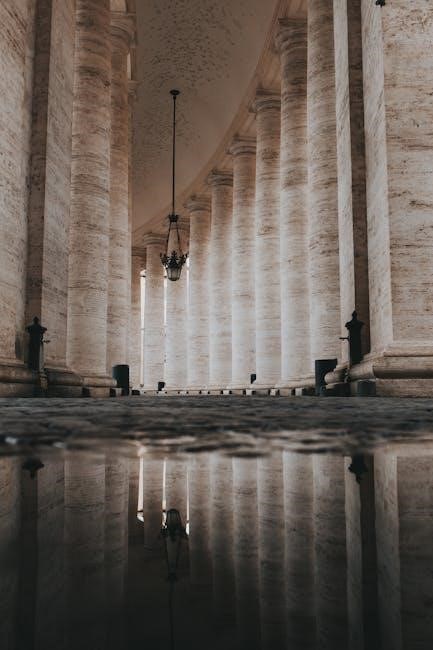
Modern-Day Secrets and Transparency
The Vatican continues to balance tradition with modern transparency‚ gradually opening archives and addressing conspiracy theories to shed light on its historical and contemporary secrecy.
Efforts to Open the Vatican Archives
The Vatican has made strides in increasing transparency by gradually opening its archives to researchers and the public. Historically‚ the Vatican Archives‚ established in 1612‚ were accessible only to scholars. However‚ recent efforts have aimed to demystify their contents‚ particularly regarding controversial figures like Pope Pius XII. Digitalization projects have made select documents available online‚ offering glimpses into the Vatican’s historical records. These initiatives reflect a shift toward openness‚ challenging the perception of secrecy. By sharing these archives‚ the Vatican seeks to provide clarity on its past and address lingering questions about its role in history. This gradual unveiling of documents highlights the Vatican’s evolving approach to transparency and its complex relationship with the public eye.
The Vatican’s Response to Conspiracy Theories
The Vatican consistently addresses conspiracy theories surrounding its secrets and activities‚ striving to clarify misunderstandings and debunk myths. By opening its archives and promoting scholarly research‚ the Vatican aims to provide factual insights into its historical actions. Officials emphasize that most documents are now accessible‚ dispelling notions of hidden truths. The Vatican also uses digital platforms to share accurate information‚ countering speculative claims about alien artifacts and secret societies. These efforts reflect a commitment to transparency‚ though conspiracy theories persist‚ often fueled by sensationalism rather than evidence. The Vatican’s approach combines patience and proactive communication to navigate the challenges posed by such theories.
The Book “The Secrets of the Vatican” by Douglas Sladen
Douglas Sladen’s 1907 book explores the Vatican’s history‚ religious significance‚ and hidden mysteries‚ offering a historical glimpse into its secretive world‚ now available as a PDF.
Overview of the Book and Its Content
Douglas Sladen’s The Secrets of the Vatican delves into the mysterious and often controversial history of the Vatican‚ exploring its religious‚ cultural‚ and political dimensions. Published in 1907‚ the book examines the Vatican’s role as a spiritual and temporal power‚ shedding light on its secret archives‚ historical events‚ and hidden traditions. Sladen’s work provides a detailed account of the Vatican’s internal workings‚ offering insights into its artistic treasures‚ theological debates‚ and the lives of its leaders. The book is now widely available in digital formats‚ including PDF‚ making its rich historical content accessible to modern readers. It remains a key resource for understanding the Vatican’s enduring mystique and its impact on global affairs.
Reception and Impact of the Book
Douglas Sladen’s The Secrets of the Vatican sparked significant interest upon its release in 1907‚ drawing both acclaim and criticism. Scholars praised its meticulous research and unique insights‚ while some critics deemed it controversial for revealing sensitive historical details. The book’s exploration of the Vatican’s hidden archives and political maneuvers resonated with the public‚ fueling broader discussions about the Church’s influence. Over time‚ the text has remained relevant‚ with its PDF version ensuring accessibility to modern audiences. It continues to be a referenced work in historical and religious studies‚ contributing to ongoing debates about the Vatican’s role in shaping global history and culture.
The Vatican remains a fascinating blend of history‚ faith‚ and intrigue‚ captivating the world with its secrets and enduring influence‚ even as truths slowly emerge.
Summarizing the Vatican’s Enduring Mystique
The Vatican’s enduring mystique lies in its unique blend of spirituality‚ history‚ and intrigue. As the spiritual center of Catholicism‚ it houses iconic landmarks like St. Peter’s Basilica and the Sistine Chapel‚ which embody artistic and religious excellence. The Vatican’s secrets‚ from hidden archives to unexplained phenomena‚ have captivated global imagination‚ fueling countless theories and legends. Its role in shaping history‚ coupled with controversies like the Vatican Bank scandals‚ adds layers to its enigmatic status. The interplay of faith‚ power‚ and mystery ensures the Vatican remains a subject of both reverence and fascination‚ making it one of the most compelling entities in human history.
The Ongoing Fascination with Vatican Secrets
The Vatican’s secrets continue to captivate global imagination‚ fueled by its mysterious archives‚ unexplained phenomena‚ and historical enigmas. From conspiracy theories about alien artifacts to legends of hidden texts‚ the Vatican’s allure lies in its blend of spirituality and intrigue. Books like Douglas Sladen’s The Secrets of the Vatican and the discovery of elongated skulls in 1998 have further amplified public curiosity. The Vatican’s response to such theories‚ often shrouded in silence‚ only deepens the mystery. This enduring fascination reflects humanity’s timeless quest to uncover hidden truths‚ making the Vatican a timeless subject of speculation and wonder. Its unique interplay of faith‚ history‚ and secrets ensures its mystique endures‚ captivating minds across generations.
